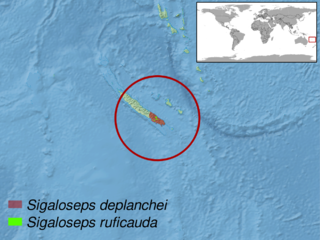
Skinks are lizards belonging to the family Scincidae, a family in the infraorder Scincomorpha. With more than 1,500 described species across 100 different taxonomic genera, the family Scincidae is one of the most diverse families of lizards. Skinks are characterized by their smaller legs in comparison to typical lizards and are found in different habitats except arctic and subarctic regions.
Calyptotis is a genus of skinks, a type of lizard, found in Australia.

Morethia, commonly called Morethia skinks or firetail skinks, is a genus of skinks in the order Squamata that are found in Australia.

Sigaloseps is a genus of skinks which inhabit the moist, closed forest of southern New Caledonia.

The star finch is a seed-eating bird species found in northern Australia. It has a distinctive red face and bill, and broad white spots down its flanks. One of its three subspecies may be extinct.
Carinascincus palfreymani, known commonly as the Pedra Branca skink, as well as the Palfreyman's window-eyed skink, the Pedra Branca cool-skink, or the red-throated skink, is a species of skink in the family Scincidae. The species is endemic to Australia, and is restricted to the windswept Pedra Branca, an island off southern Tasmania of only 2.5 ha, where it is dependent on the seabird colonies. It is the only lizard species found on the island.

The rufous-tailed weaver is a species of songbird found in Tanzania.

Carinascincus metallicus, the metallic cool-skink or metallic skink is a species of skink in the family Scincidae. It is endemic to Australia, found in southern Victoria, as well as in Tasmania where it is the most widespread and common lizard, occurring on many offshore islands in Bass Strait as well as the mainland. It gives birth to live young. It is highly variable in colour and pattern, and may be a complex of closely related species.

Menetia greyii, commonly known as the common dwarf skink or Grey's skink, is a species of lizard in the family Scincidae. The species is native to mainland Australia and Indonesia.

Morethia boulengeri is a species of lizard in the family Scincidae. The species is endemic to Australia.

The four-toed earless skink, also known commonly as Péron's earless skink, the lowlands earless skink, or the four-toed mulch skink, is a viviparous earless skink endemic to southern Australia.

Tiliqua scincoides is a species of skink. It is native to Australia as well Tanimbar Island.

Eugongylinae is a subfamily of skinks within the family Scincidae. The genera in this subfamily were previously found to belong the Eugongylus group in the large subfamily Lygosominae.

The redtail emo skink is a species of lizard in the family Scincidae. It is found in the Philippines and possibly Sulawesi.
Morethia lineoocellata, the West Coast morethia skink or western pale-flecked morethia, is a species of skink found in Western Australia.
Morethia storri, also known commonly as the top end firetail skink or Storr's morethia, is a species of lizard in the family Scincidae. The species is endemic to Australia.
Morethia taeniopleura, the northeastern firetail skink, is a species of skink found in Queensland in Australia.

Sigaloseps ruficauda is a species of skink found in New Caledonia.
The red-tailed calyptotis is a species of skink found in New South Wales in Australia. They are oviparous reptiles, and they are a part of the scincidae family.
The ghost skink is a species of skink endemic to Australia.













